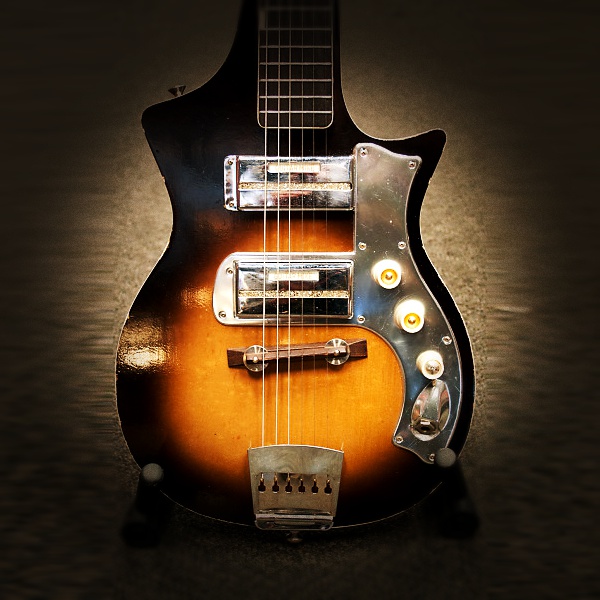

Look for the serial number in the neck pocket. Carefully separate the neck from the body of the guitar. Remove the strings and unscrew the screws at the base of the neck.

Other than “on" and “off," it's not exactly clear what these switches do under the hood. With four single-coil pickups, two volume dials for those pickups, and six switches-three for each pickup-there are plenty of sonic options, from twangy to tic-tac to warm and fat to bright and spanky. That's because of the controls under the guitar's metal and chrome panels, which remind me of many Teiscos I've seen. Not only does the VN-4 baritone have the cool “surfcaster" look of that era, I think it's also got more versatile tones than, say, a Fender Bass VI. The headstock says … what? Is Demian really spelled with three Ms? This is more of a mess than a logo or brand name. This Demian VN-4 and its cousins were made to cash in on the baritone guitar craze that started in the late 1950s in the U.S., where the instrument became a staple of surf music, Duane Eddy's twangy hits, and country music sessions, and later figured prominently in spaghetti Western soundtracks and Jimmy Webb's orchestrations for Glen Campbell's hits “Galveston" and “Wichita Lineman." A VN-4 in good shape, like this guitar, might sell for up to $750, or scale down to $400 if it's had a rougher life. I was holding a part of that historic lineage in my hands. George, Zim-Gar, and their own Demian imprint, they've made guitars for Teisco, Guyatone, Kawai (think Hound Dog Taylor's S180), Ibanez, and even Fender. FujiGen has been a keystone in Japan-based guitar building for ages. This was extra exciting for me, because the history of this company is extraordinary. What we were very lucky to have was an extremely rare Demian VN-4 baritone electric guitar from 1964 made by the FujiGen instrument manufacturing company in Matsumoto, Japan. With some sleuthing, the answers started coming in.

1-4 on/off switches, R and S settings, and a pair of volume wheels are all ready to take the sound of this VN-4 for a spin.

Maybe that's because both companies were helped along in their development by a guitar designer named Atsuo Kaneko? But I digress.ĭig these crazy controls! Mic. I felt like this one had a Teisco body, but the pickups looked like they were made by Guyatone. Especially since the manufacturer made a mess of the brand name on the headstock, which looks like a doctor's scribble at the bottom of a prescription.Īs my fellow PG columnist Frank Meyers often explains in his monthly “Wizard of Odd," these inexpensive Japanese guitars from the '60s-regardless of the names on their headstocks-all have a pretty similar aesthetic. This was obviously a Teisco of some kind, I thought, but some research was in order. But what really caught my eye was the neck, which was unusually long compared to the frequent flow of other Teisco, Guyatone, and Kawai relics that come in. This was obviously a Teisco of some kind, I thought, but some research was in order.Īt first glance, this guitar was immediately weird, with four pickups, two volume dials, and six switches.


 0 kommentar(er)
0 kommentar(er)
